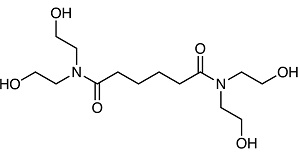HI! I’M ELEMENT AI.
Hydroxyalkyl Amide

Product Description
Hydroxyalkyl amide is a chemical compound with various industrial applications.
Product:
Hydroxyalkyl Amide
CAS:
6334-25-4
Synonym:
N,N,N′,N′-Tetrakis(2-hydroxyethyl)adipamide; N,N,N',N'-Tetrakis(2-hydroxyethyl)-hexanediamide
Structure:

Typical Characteristics
Appearance
White to slightly pale yellow powder
Density
1.239 g/cm3
Melting point
126-130 °C
Molecular Weight
320.38
Purity
>98%
Uses, Applications & Markets
Key applications
get a quote
We Offer Hydroxyalkyl Amide
in various grades
A few of the grades available are listed below:



Hydroxyalkyl Amide used in many
industry applications
Hydroxyalkyl amide is a chemical compound with various industrial applications. Here are some of its main uses:
- Surfactants: Hydroxyalkyl amides are utilized as nonionic surfactants in various cleaning and personal care products. They exhibit excellent wetting, dispersing, and emulsifying properties, making them suitable for use in liquid detergents, shampoos, hand soaps, and industrial cleaners. They help to reduce surface tension, improve soil removal, and enhance the stability of formulations.
- Textile Auxiliaries: These compounds find applications in the textile industry as softeners, lubricants, and antistatic agents for fabrics and fibers. They can impart softness, smoothness, and static control to textile materials, improving their hand feel, appearance, and processability. Additionally, they may act as dye dispersants or leveling agents in dyeing and printing processes.
- Paints and Coatings: Hydroxyalkyl amides are used as rheology modifiers and film-forming agents in water-based paints, coatings, and adhesives. They contribute to the viscosity control, thickening, and flow properties of paint formulations, allowing for ease of application and improved coating performance. Moreover, they can enhance the adhesion, flexibility, and durability of paint films on various substrates.
- Personal Care Products: These compounds are employed in cosmetic and personal care formulations, such as creams, lotions, and hair care products. They serve as emollients, moisturizers, and conditioning agents, providing hydration, skin barrier repair, and hair conditioning benefits. Hydroxyalkyl amides can improve the spreadability, absorption, and sensory attributes of skincare and haircare formulations.
- Emulsifiers: Hydroxyalkyl amides act as emulsifiers or co-emulsifiers in the formulation of oil-in-water (O/W) and water-in-oil (W/O) emulsions. They help stabilize emulsions by reducing interfacial tension between immiscible phases and preventing phase separation. These compounds are commonly used in the preparation of creams, lotions, emulsions, and cosmetic emollients.
- Industrial Lubricants: In industrial applications, hydroxyalkyl amides are employed as lubricity agents and corrosion inhibitors in metalworking fluids, hydraulic fluids, and lubricating oils. They can reduce friction, wear, and metal-to-metal contact in machinery and equipment, improving operational efficiency and extending component life. Additionally, they offer rust protection and metal surface passivation in aqueous environments.
- Adhesive Additives: Hydroxyalkyl amides may be incorporated into adhesive formulations as tackifiers, plasticizers, or viscosity modifiers. They help enhance the adhesion strength, flexibility, and tackiness of adhesives, facilitating bonding to various substrates. These compounds are commonly used in pressure-sensitive adhesives (PSAs), construction adhesives, and sealants.
- Polymer Additives: These compounds can serve as additives or modifiers in polymer formulations to impart desired properties or performance enhancements. They may act as compatibilizers, impact modifiers, or processing aids in thermoplastic and thermoset polymers. Hydroxyalkyl amides can improve polymer processing, mechanical properties, and surface characteristics.
- Concrete Additives: Hydroxyalkyl amides find applications in the construction industry as superplasticizers and water reducers in concrete formulations. They help improve the workability, flowability, and strength development of concrete mixes, allowing for the production of high-performance concrete with reduced water content and enhanced durability. These compounds are commonly used in precast concrete, ready-mix concrete, and self-consolidating concrete (SCC).
- Food Additives: In the food industry, hydroxyalkyl amides may be used as emulsifiers, stabilizers, or thickening agents in food products and formulations. They can improve the texture, mouthfeel, and shelf stability of food products, such as sauces, dressings, and desserts. These compounds are generally recognized as safe (GRAS) for use in food applications.